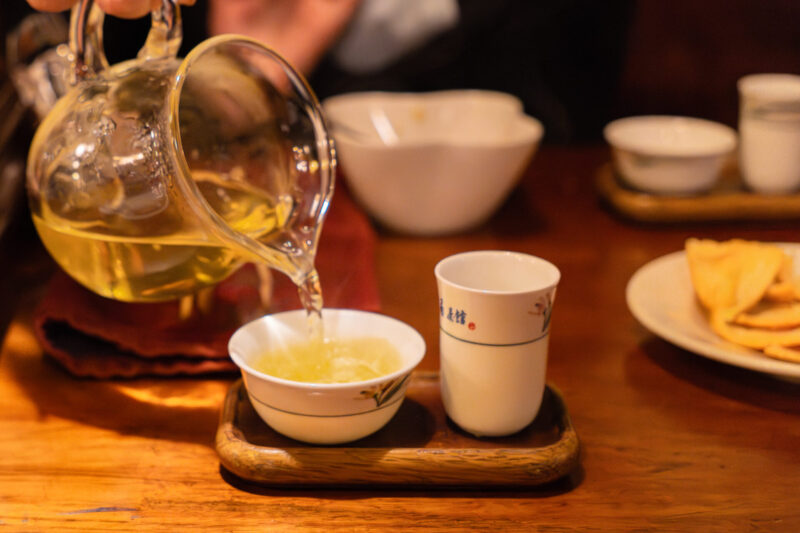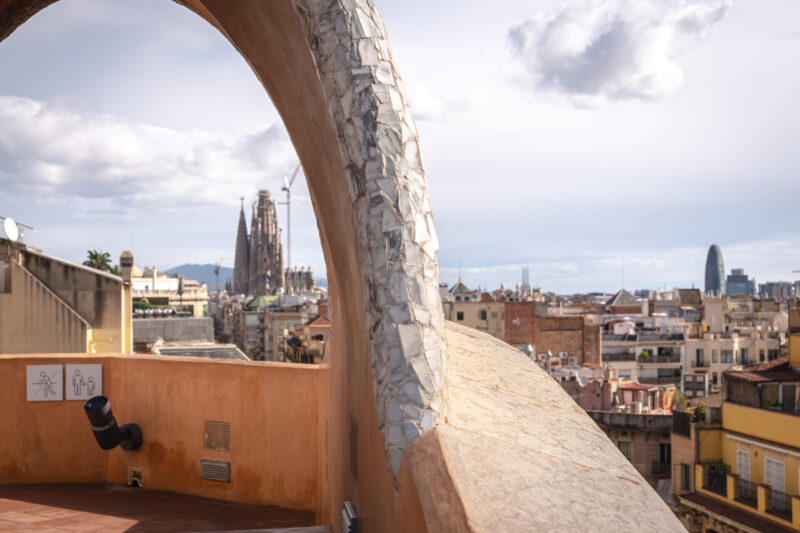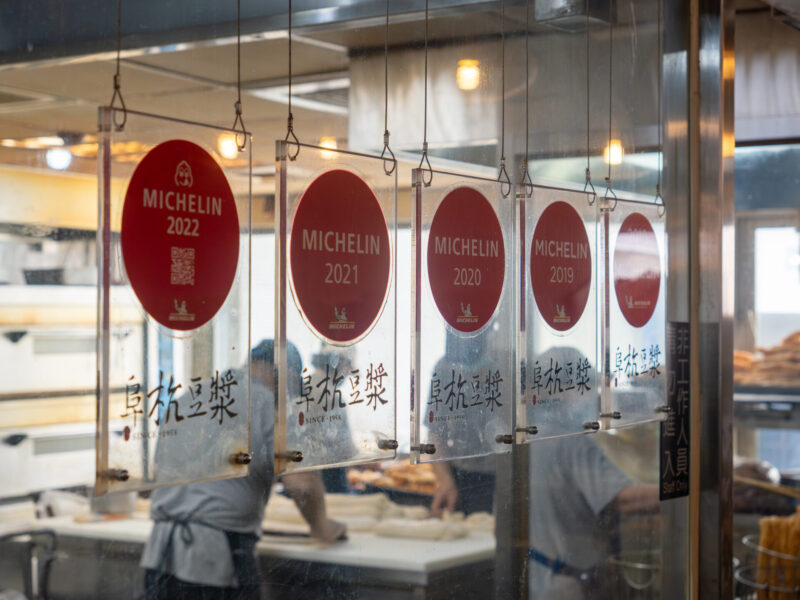About MUME

Concept
Rooted in the spirit of Nordic cuisine, MUME is a modern gastronomy restaurant from Taipei that expresses the terroir and seasonality of Taiwan to the fullest.
The team works in close collaboration with local farmers and artisans, sourcing most ingredients domestically. Rather than reconstructing traditional Taiwanese dishes, MUME takes a bold, site-specific approach, pursuing flavors that can only be created “here and now.”
Each plate unfolds a refined and tranquil world—an elegant contrast to the bustle of Taipei. Nordic techniques like fermentation, smoking, and texture play are subtly integrated throughout. Despite its casual ambiance, the menu structure and culinary flow are meticulously crafted, offering a compelling answer to why MUME garners international acclaim.
Chef Richie Lin
At the helm is Singaporean chef Richie Lin, whose culinary journey includes world-renowned establishments such as Noma in Denmark and Quay in Australia.
Blending his global experience with a profound respect for Taiwan, Lin has created a new form of “local gastronomy”—not fusion, but a new identity rooted in place.
His commitment to working with emerging local producers and artisans, and his emphasis on team-based collaboration, speak to a broader culinary philosophy that extends beyond the plate.
Awards & Recognition
Now a pillar of Taipei’s gastronomic landscape, MUME quickly rose to prominence. Within just a few years of opening, it debuted at 43rd place on the Asia’s 50 Best Restaurants list in 2018. By 2022, it climbed to 15th, cementing its status as a representative of Taiwanese fine dining.
MUME also earned a Michelin star in the inaugural 2018 Michelin Guide Taipei, a distinction it has continued to uphold. Its balanced focus on innovation and reverence for local ingredients continues to captivate gourmets worldwide.
Beyond the restaurant, Chef Richie Lin has also been recognized for his advocacy of sustainable food culture, frequently invited to speak at international conferences and events.
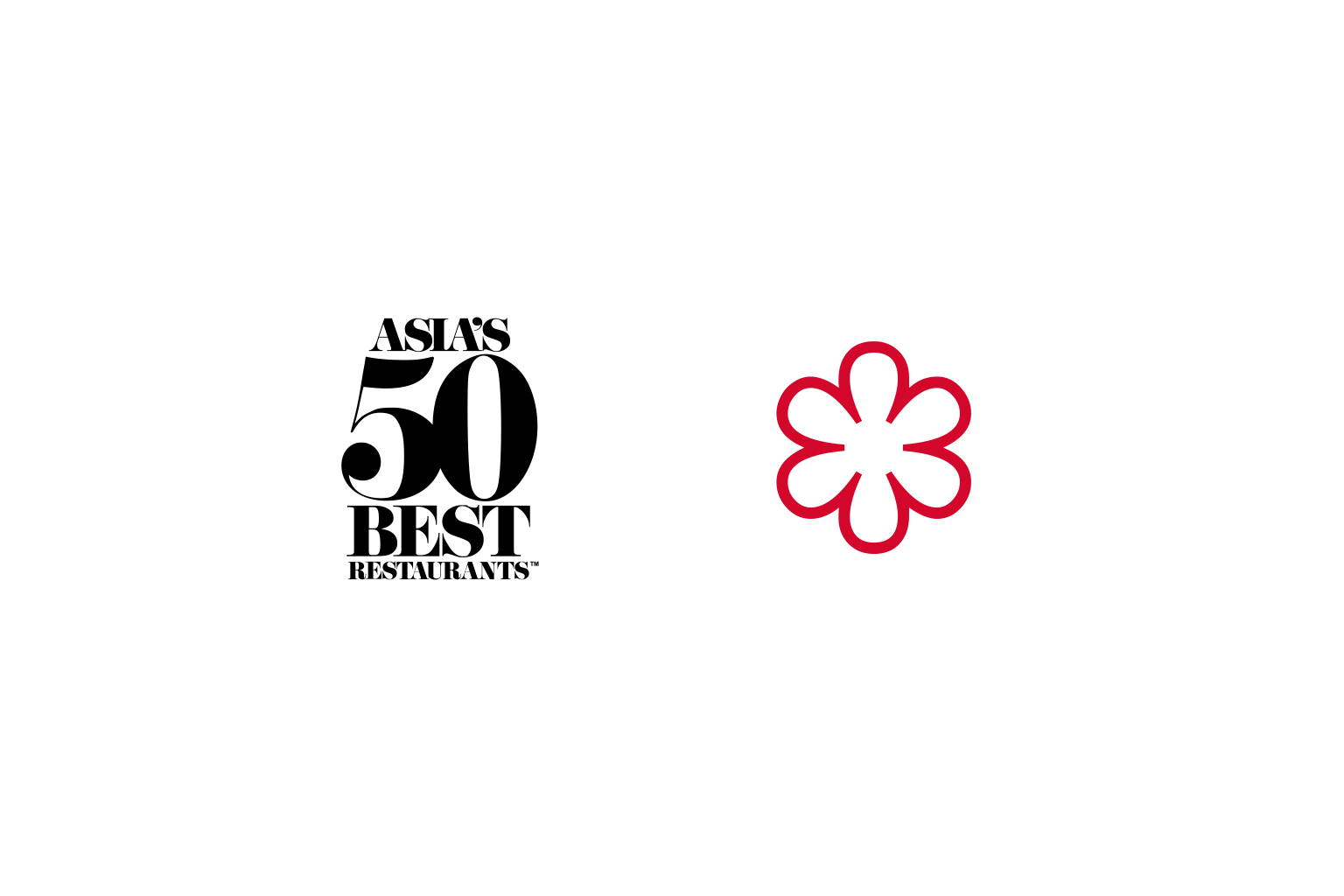
Dining Prelude
Exterior & Entrance
Nestled on a quiet street in Taipei’s Da’an District, MUME blends into the scenery so discreetly that one might pass it by without realizing it’s a restaurant. The façade is minimal, combining raw concrete with warm wood. No large signage marks the spot—just a faint glow through a glass door, inviting guests into what feels like a hidden atelier.
A touch of greenery at the entrance softly bridges nature and architecture. Open the door on a humid Taipei evening, and you’re welcomed into a space of serene sophistication.
MUME’s “hidden gem” presence quietly echoes the restaurant’s philosophy: refined, thoughtful, and unpretentious.
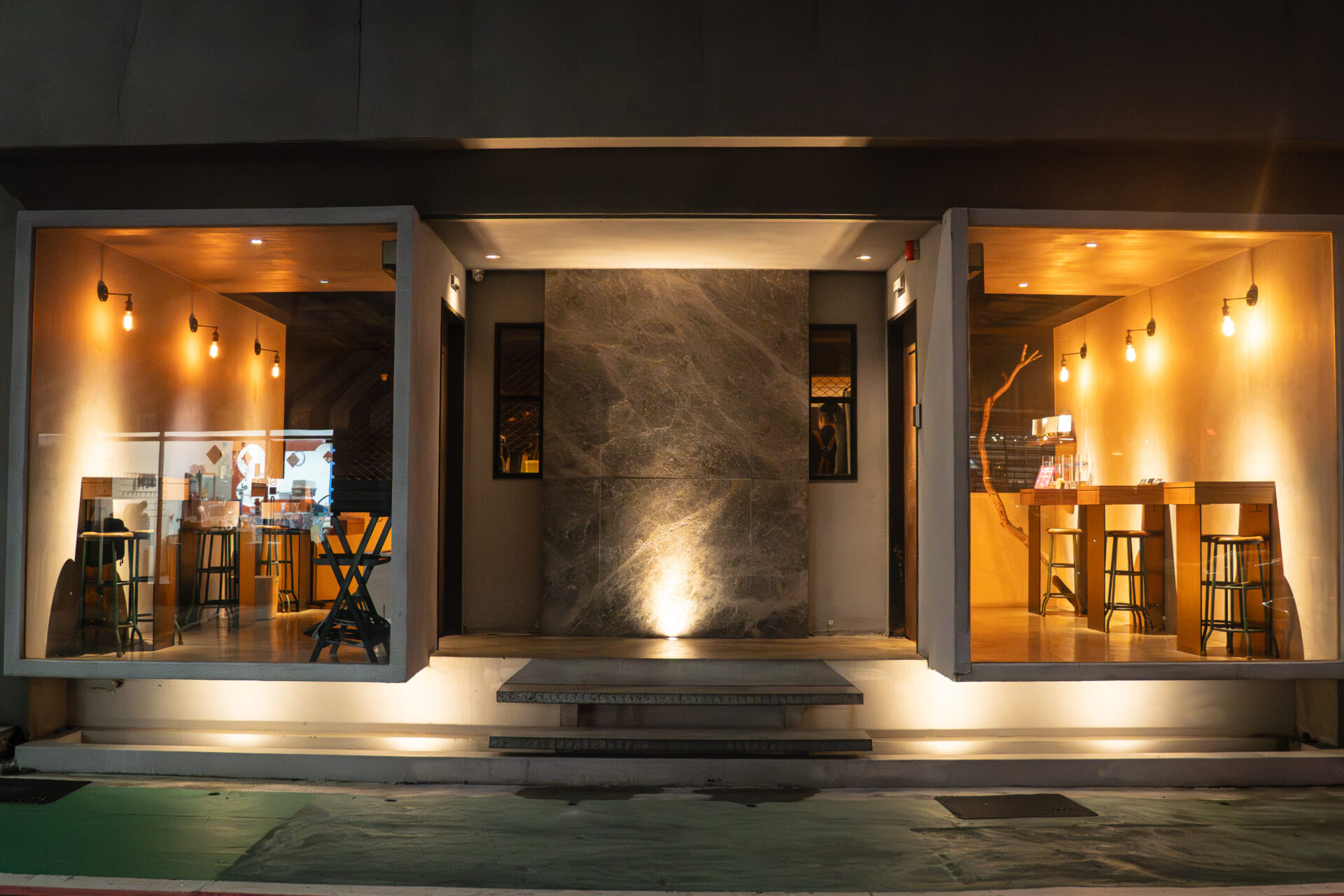
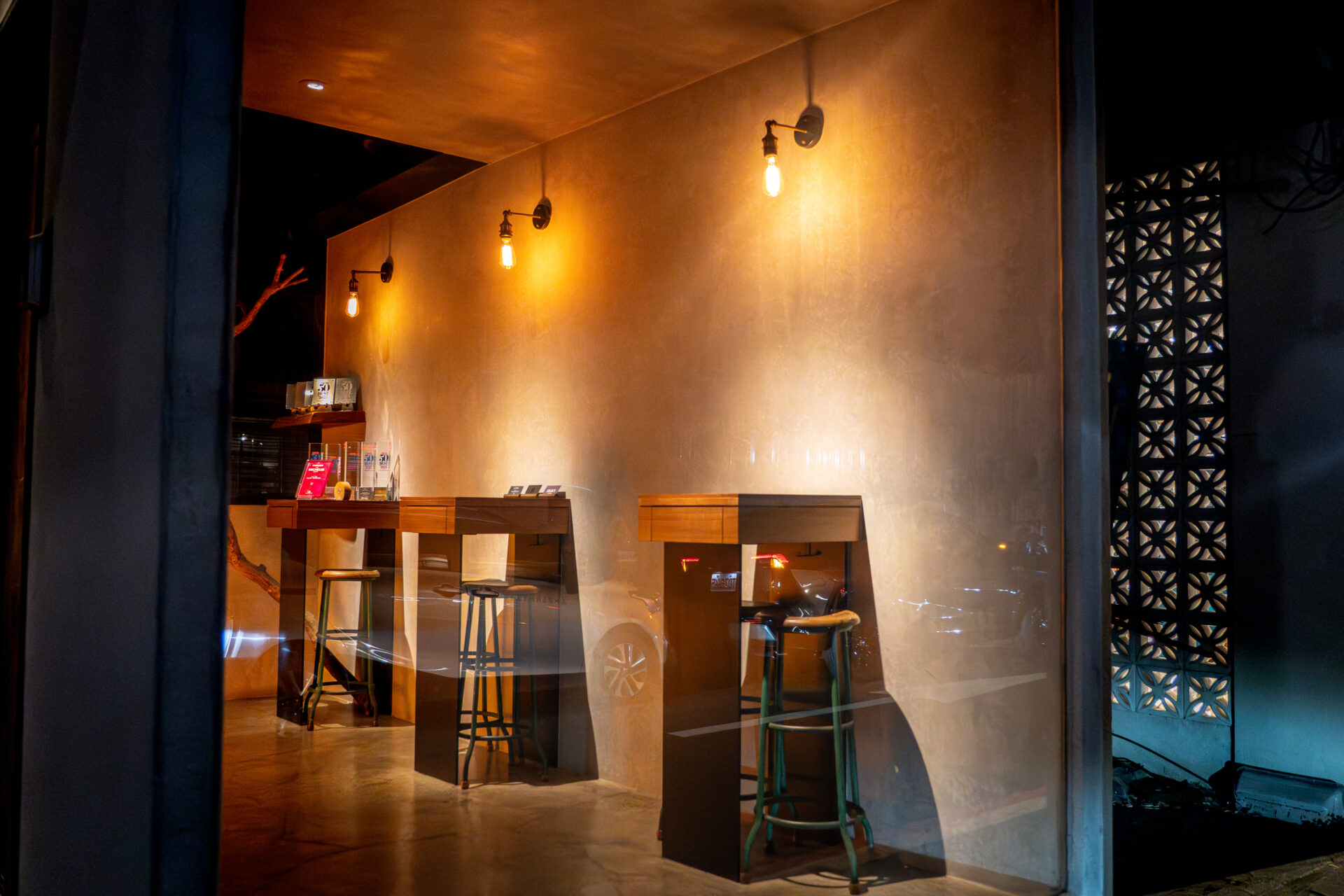
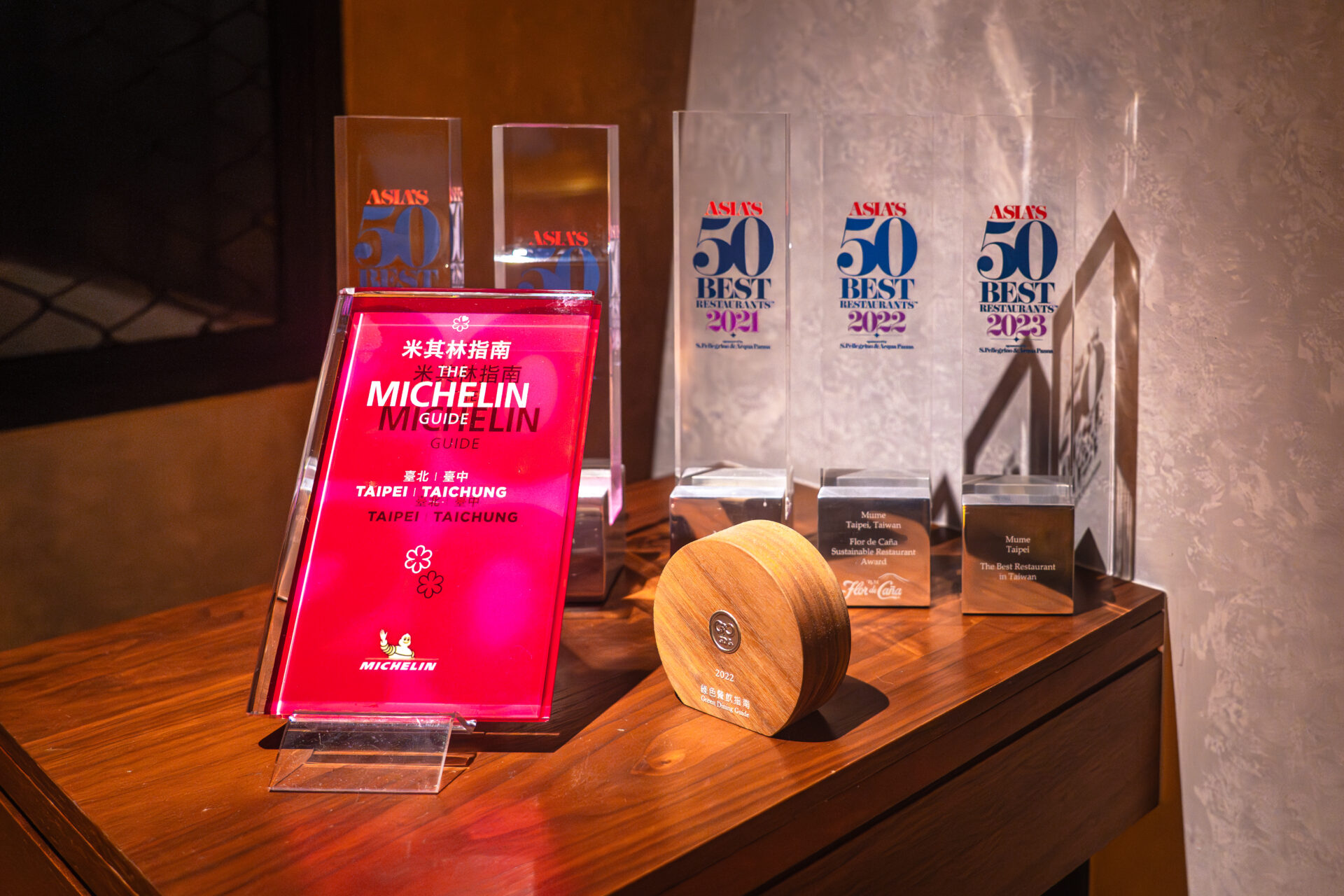
Dining Space
The interior of MUME feels like a modern atelier where calmness and quiet intensity coexist. The space is wrapped in matte dark tones with understated lighting that naturally draws attention to the dishes and conversations.
Each wooden table is set simply with felt mats, ceramic-inspired dishware, and candlelight—minimal yet warm. Background music is barely noticeable, striking the perfect balance between ambiance and focus.
At the center of the space is a glowing onyx-style drink counter, casting soft amber light and anchoring the room. Above it, neatly arranged glasses and bottles showcase a curated selection of natural wines and Taiwanese craft spirits.
The kitchen, slightly elevated, offers glimpses of the staff in motion through glass and open partitions. Shelves filled with jars of fermenting fruits, vegetables, and spices provide a visual testament to MUME’s core values: fermentation, time, and craftsmanship.
Details like rope-hung lights elevate Asian rusticity into a refined aesthetic, while the spatial design as a whole serves as a stage for the cuisine. Every corner reflects MUME’s identity—a thoughtfully composed, immersive dining environment.
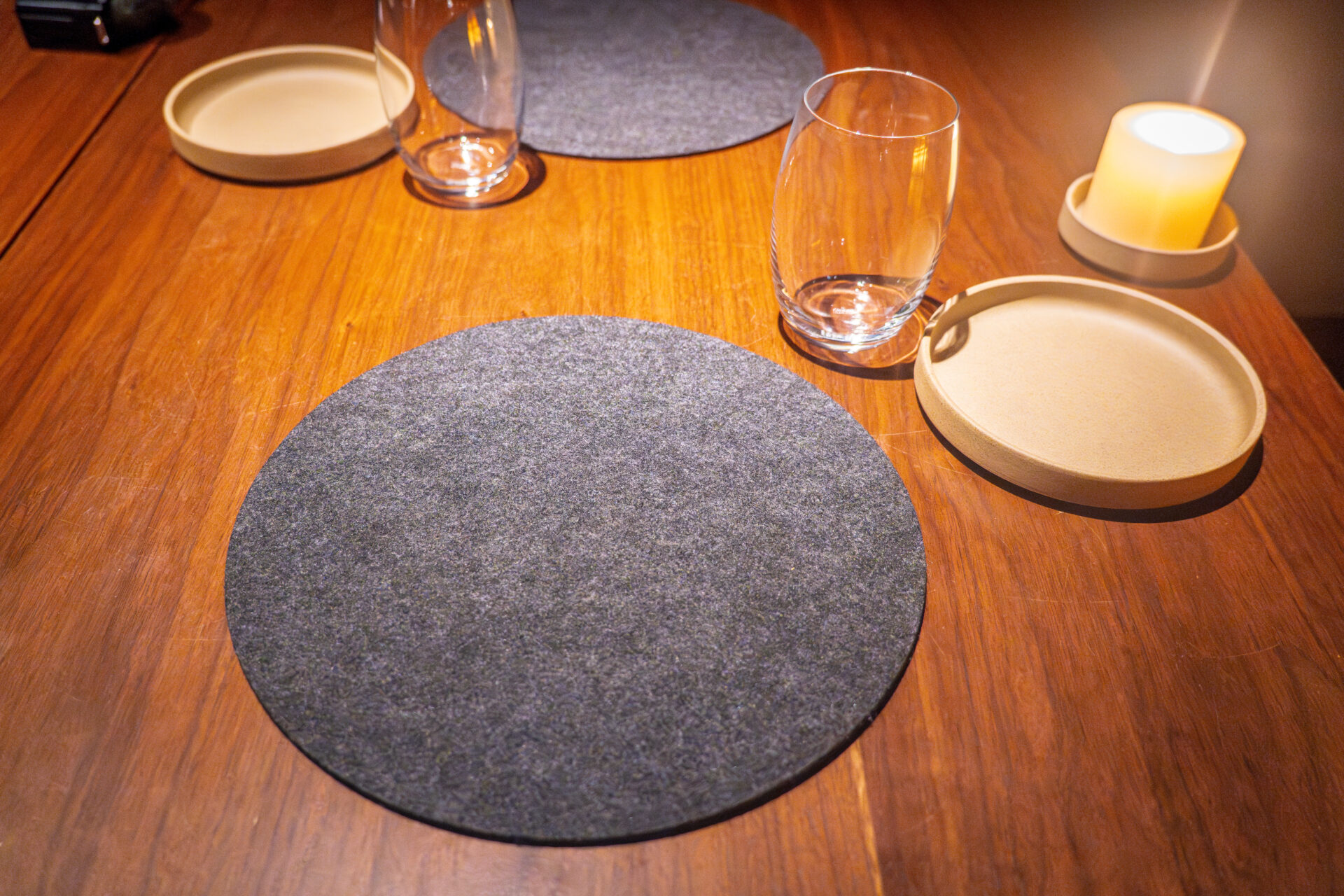

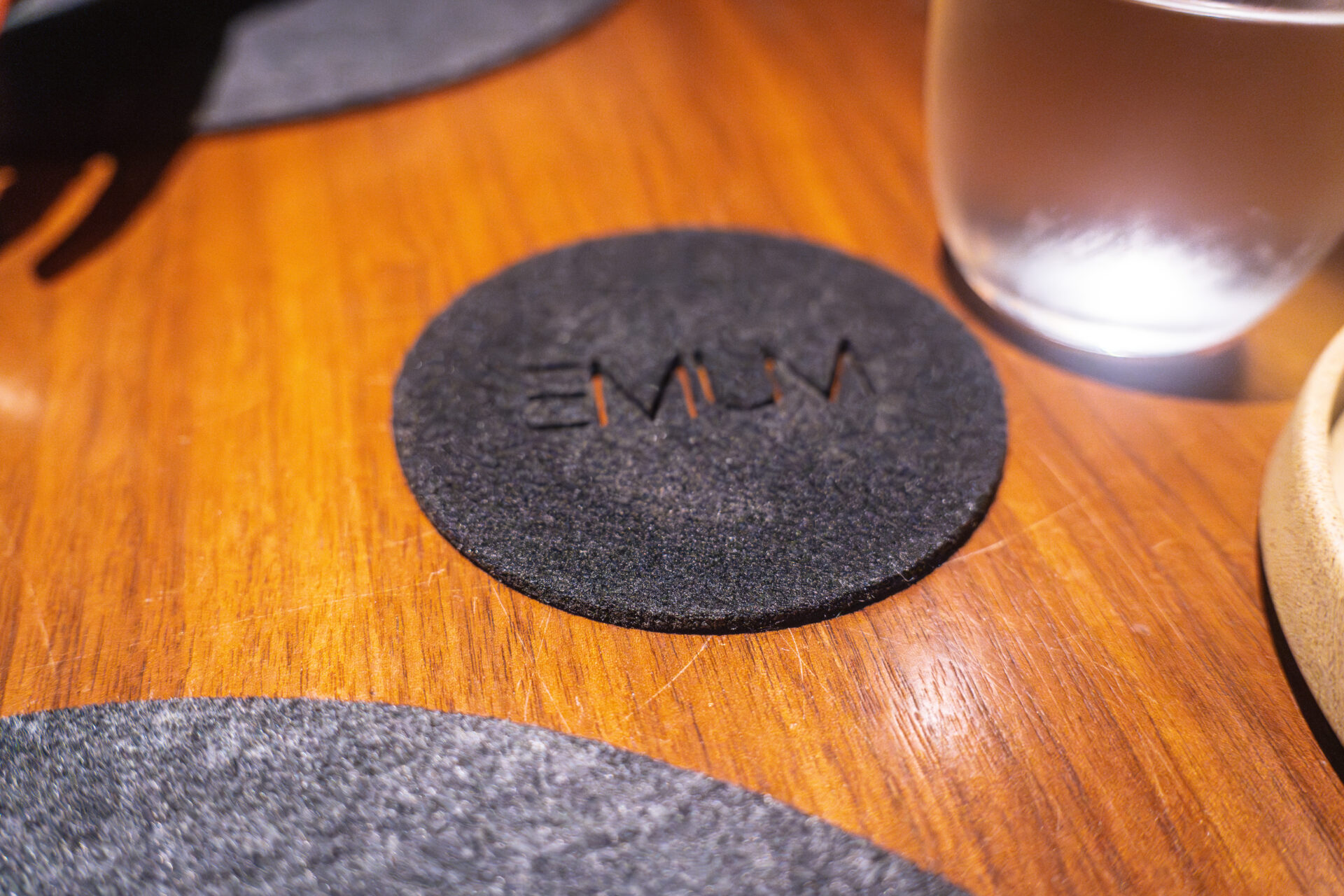

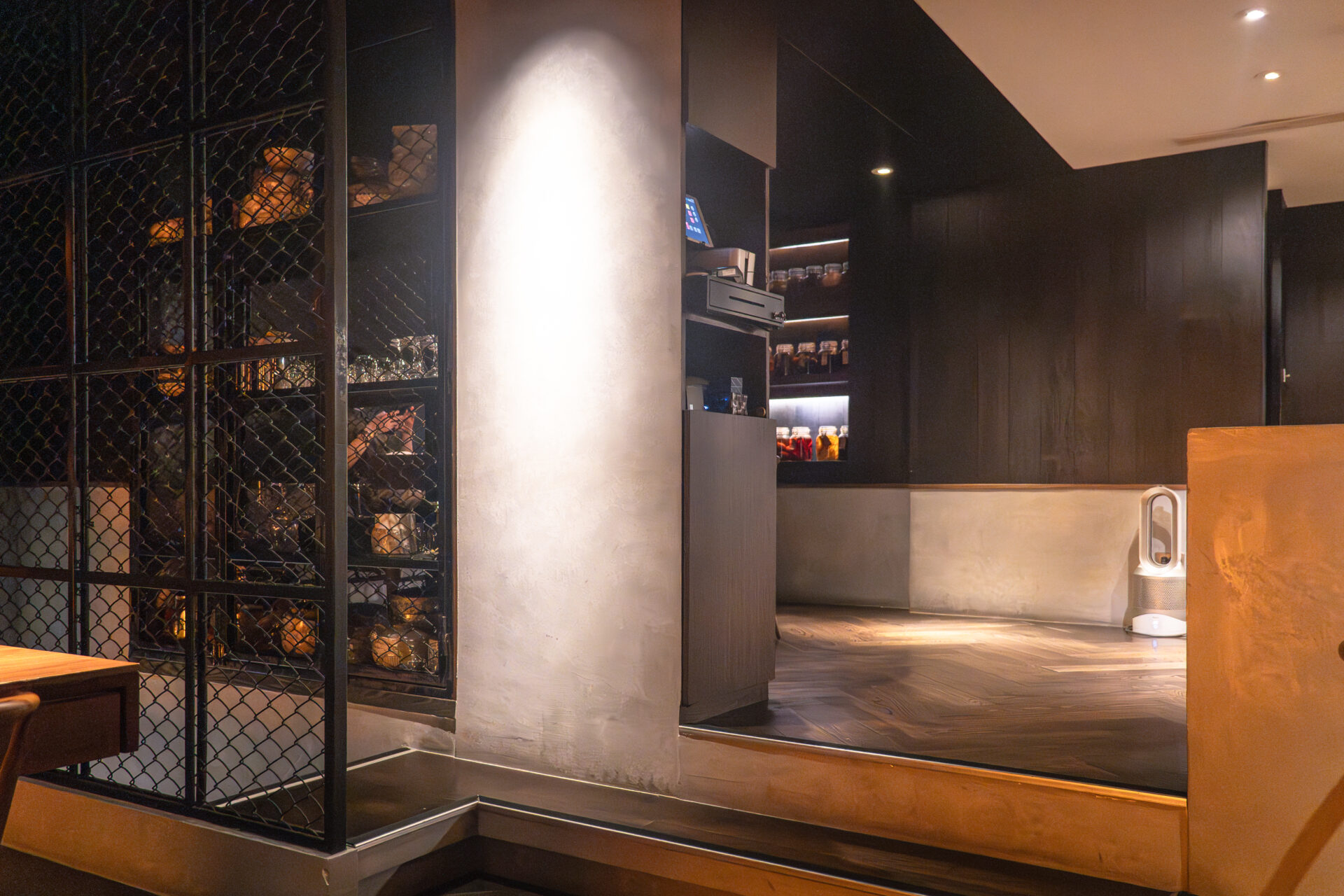
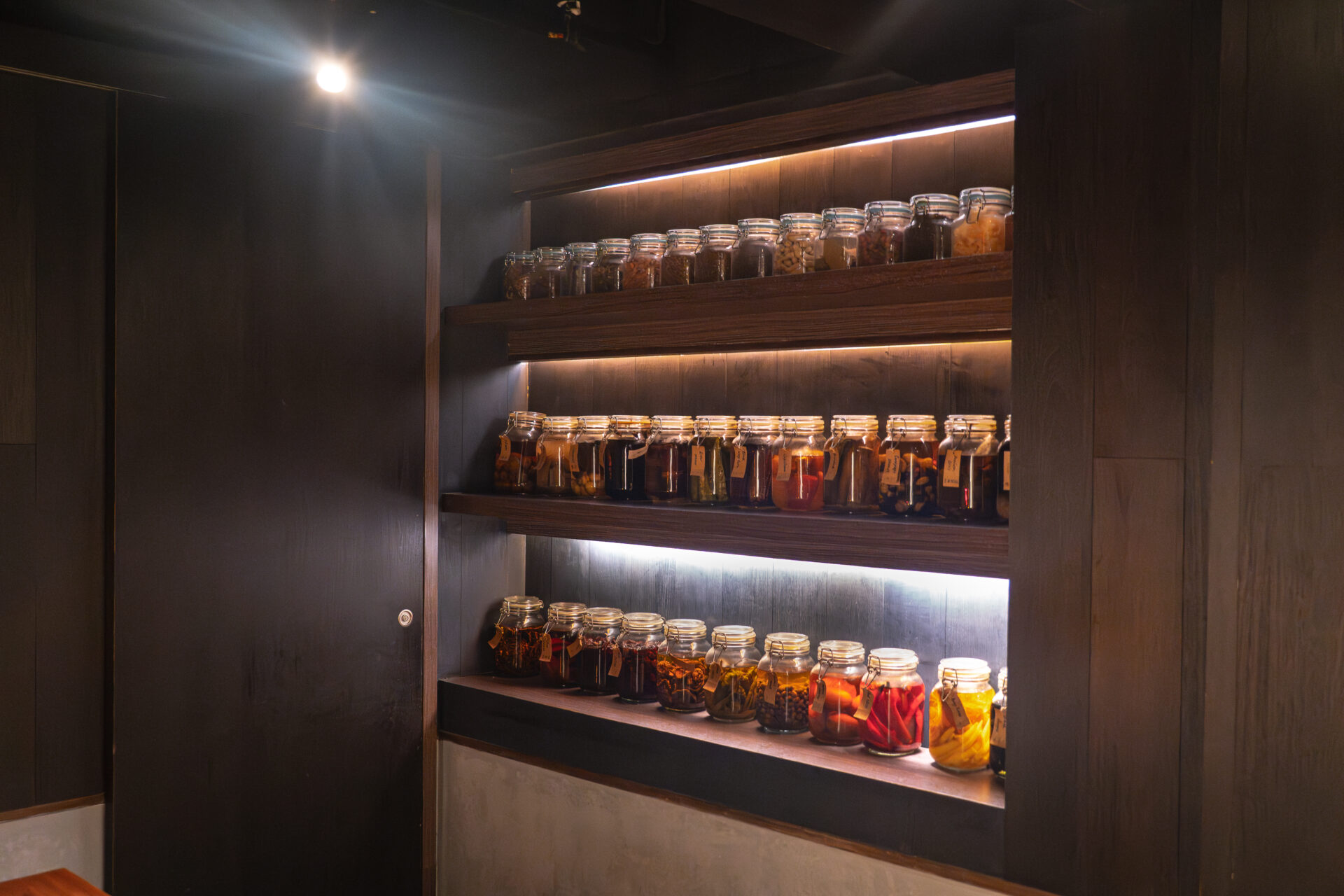
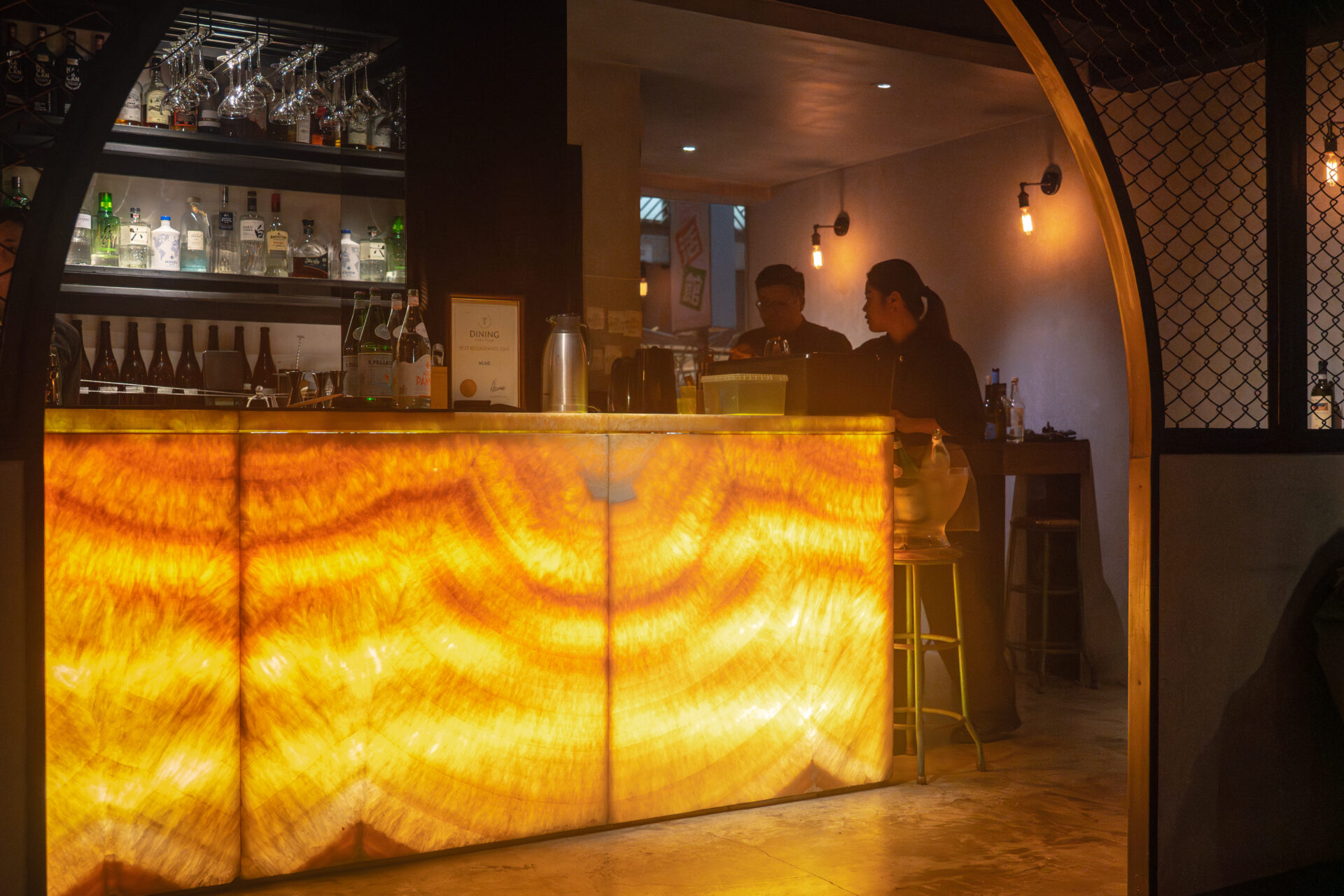
Menu Presentation
The tasting menu that day featured nine courses built around seasonal ingredients from across Taiwan. A beautifully letterpressed menu card, printed in both English and Chinese, set the tone: at MUME, presentation is part of the experience.
The first line read:
Yilan Red Prawn / Loquat / Makauy—
Fresh prawns from Yilan, the native Taiwanese pepper Makauy, and seasonal loquat signaled a multisensory exploration of the island’s bounty.
Other highlights included:
-
Abalone paired with white bitter melon and fermented pineapple
-
Cuttlefish with house-made spicy nduja and red pepper
-
Yulu duck from Changhua served with mulberries and red lettuce
The menu closed with:
Choux au Craquelin / Rose / Camellia,
featuring jasmine and camellia oil—a fragrant, floral Taiwanese finale.
Rather than following conventional formats, the meal was a meditation on how to translate a place and its culture into cuisine—at once simple and thought-provoking.
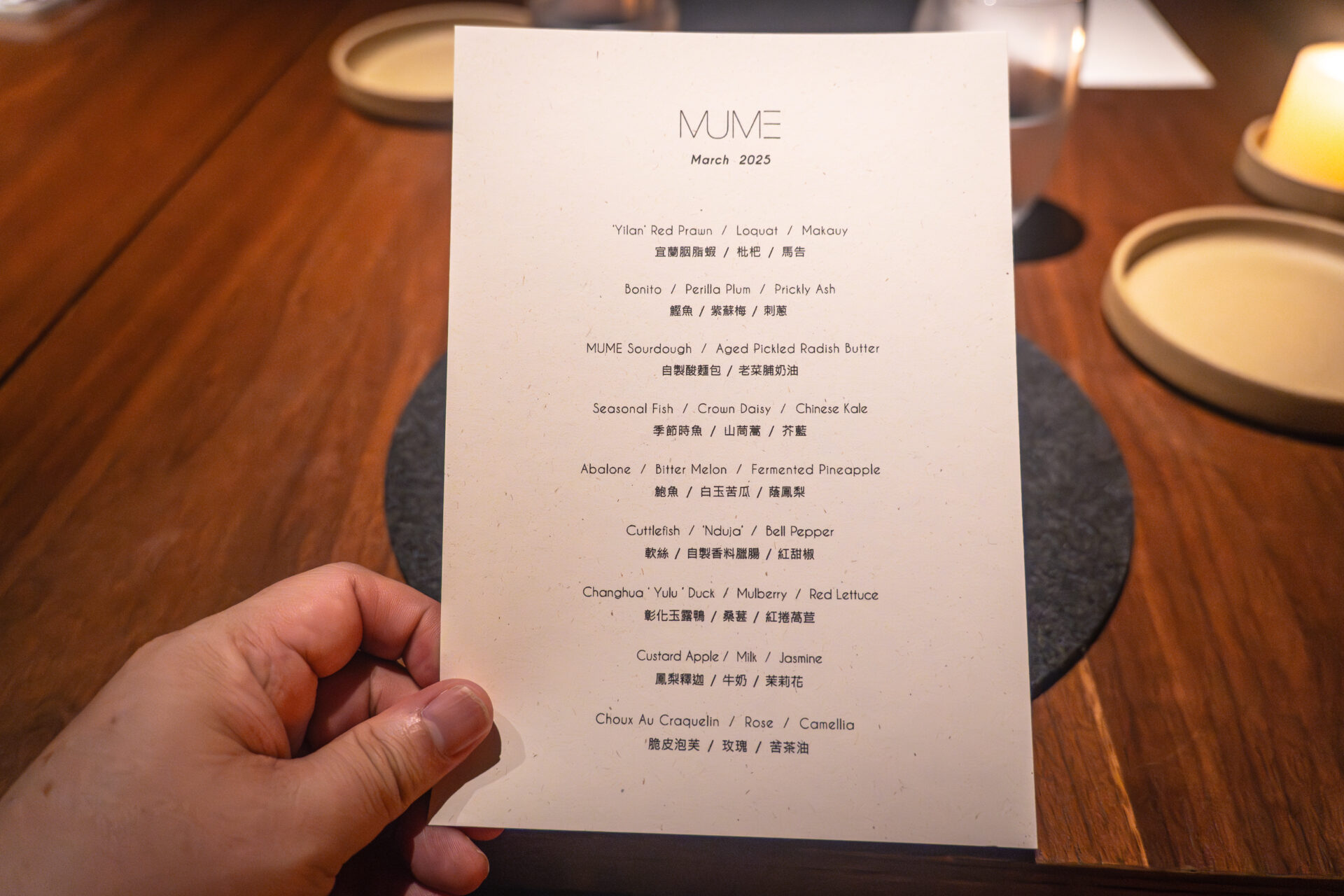
Starter Drink
The opening toast came with a natural wine from the Peloponnese, Greece:
KTIMA TSELEPOS “BLANC DE GRIS 2023.”
Served chilled, this Pinot Gris offered a soft yet defined acidity, with notes of citrus and white blossoms dancing in the candlelight—quietly exhilarating.
Its fresh fruit and mineral character paired seamlessly with the prawn and peppercorn dish. MUME’s thoughtful incorporation of global wines into a Taiwan-rooted menu reveals a free-spirited, intuitive approach to pairing.
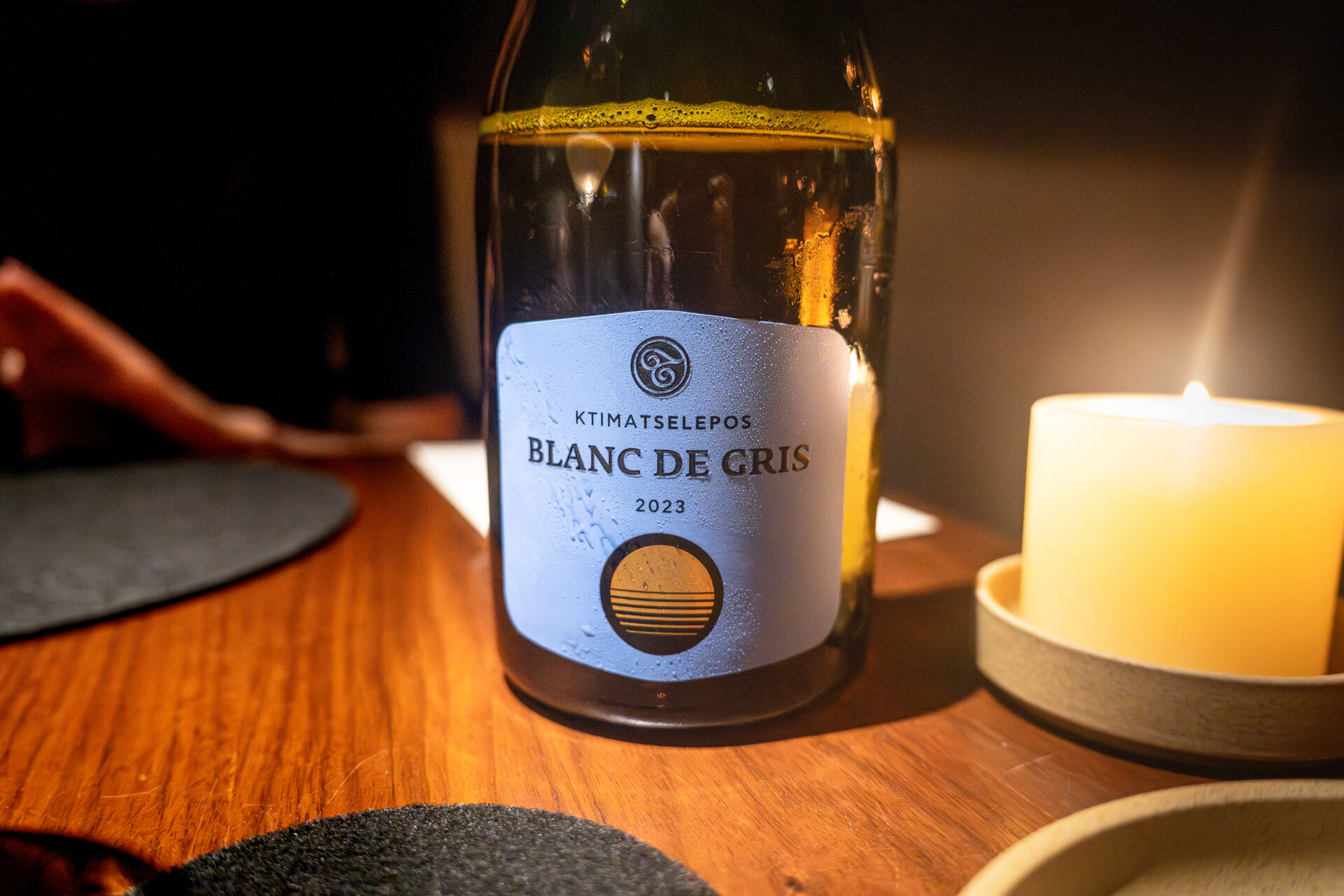
Highlighted Dishes
Ginger Curd / Dill / Wild Lettuce
The first course of the evening was a chilled appetizer, vibrant green in color and evocative of early spring. At the bottom of the glass was a smooth ginger curd (薑汁凝乳), delicately spiced. On top, a vivid sauce made from wild Taiwanese lettuce (Sonchus arvensis, known locally as カキバチシャノキ) added both color and bitterness, along with green peas and fragrant shiso blossoms.
Each element—the silky texture, the granular mouthfeel, and the aromatic accents—stood out individually yet merged seamlessly in the mouth. The lightness of dill and the gentle heat of ginger created a harmony reminiscent of where Asian tradition and Nordic minimalism intersect.
This dish layered sweetness, saltiness, acidity, and bitterness with such subtlety that it delivered a quiet yet lasting impact—a fitting prelude to the rest of the course.

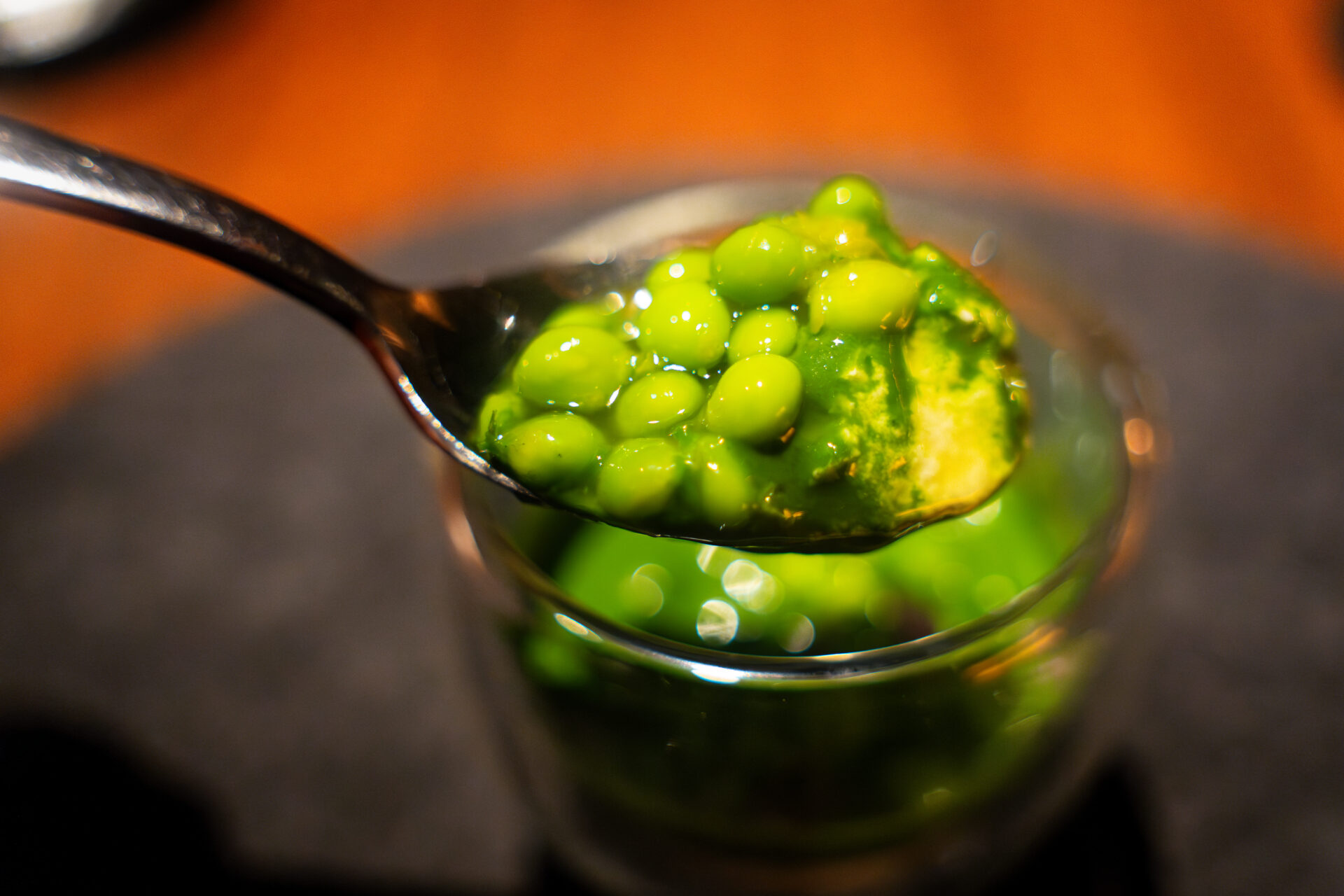
Yilan Red Prawn / Loquat / Makauy
The second course featured fresh red prawn from Yilan, served cold. The succulent prawn was paired with loquat pulp and juice—a nod to early summer—while Makauy, a native Taiwanese mountain pepper, added aromatic complexity.
The gentle sweetness and juicy acidity of the loquat enhanced the richness of the prawn, while the crisp, citrusy spice of Makauy lifted the entire dish beyond a simple fruit-forward plate. Fresh herbs and edible flowers gave the final touch, resulting in a dish that felt like a celebration of Taiwan’s early summer in full bloom.
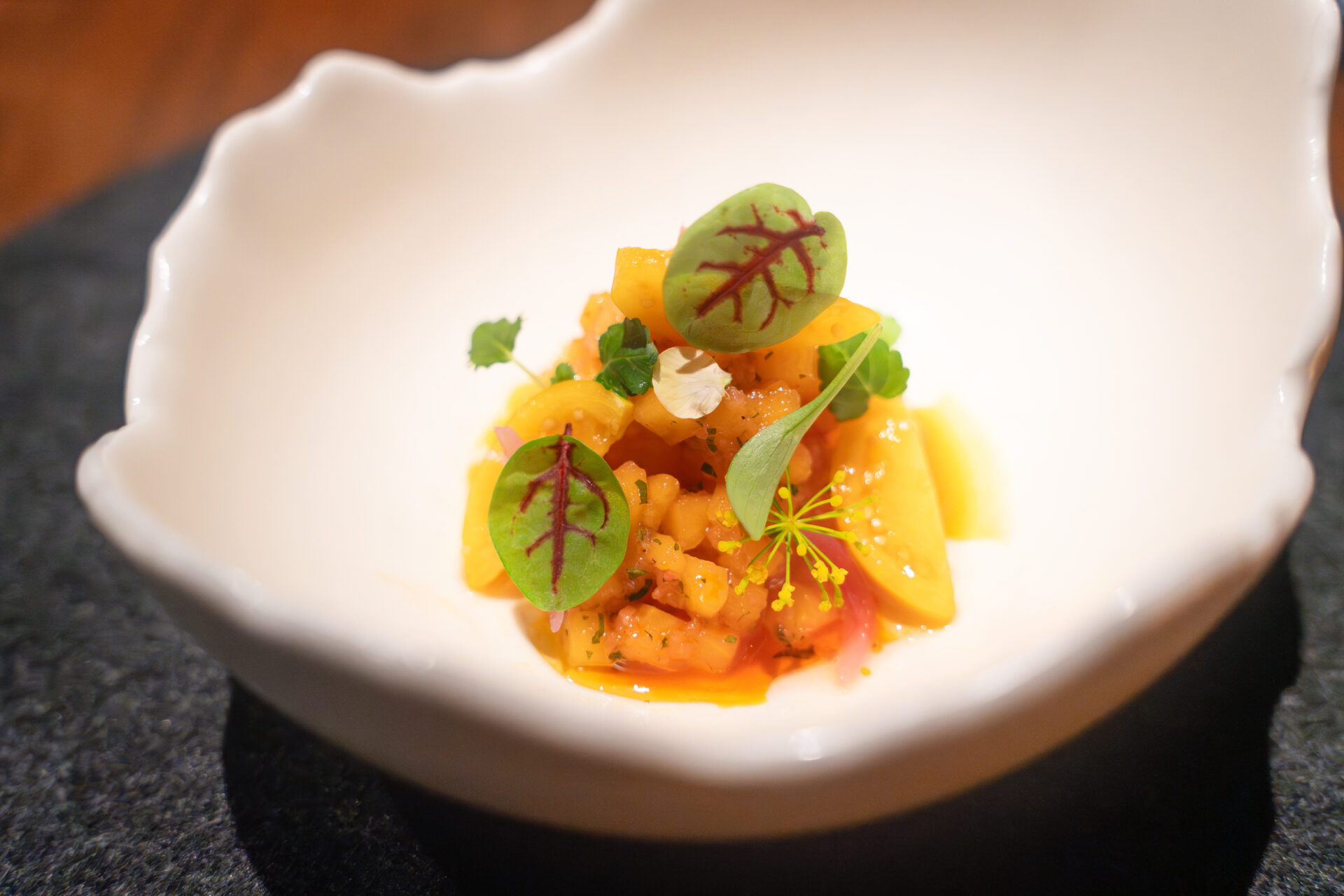
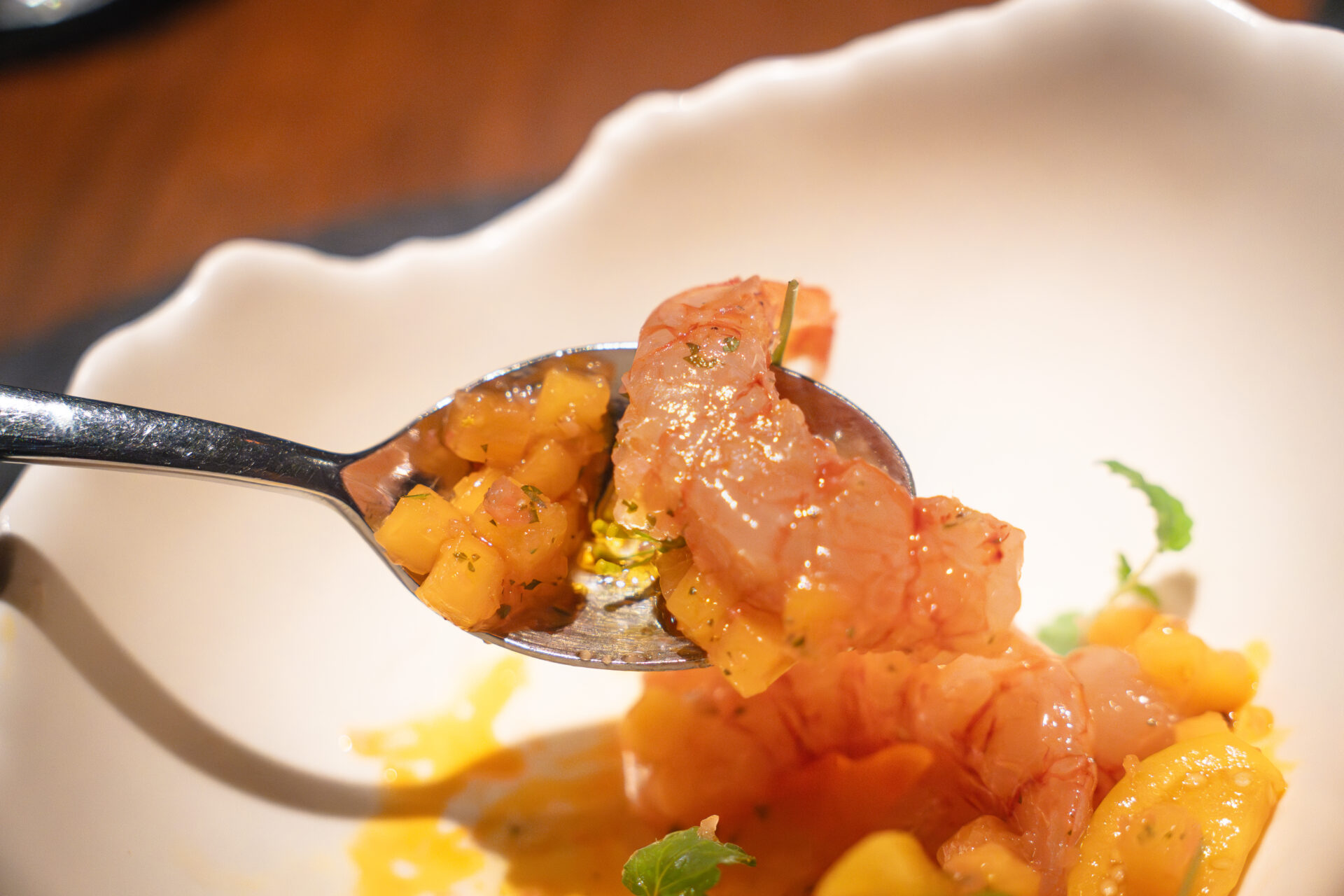
Bonito / Perilla Plum / Prickly Ash
A true signature dish at MUME, this course captivated the eye with vivid gradients of oil and sauce. At the center was aged bonito, tender and umami-rich. Layered above were shiso leaves, red onion, and delicate sprouts.
The sauce was crafted from Taiwanese perilla plum and Prickly Ash (a cousin of Sichuan peppercorn). Upon tasting, waves of sourness, fragrance, and subtle spice burst across the palate, perfectly complementing the richness of the fish.
Visually striking and intellectually refined, this dish was a symphony of fermentation, sashimi sensibility, and Nordic design. It stands as an iconic embodiment of MUME’s philosophy.
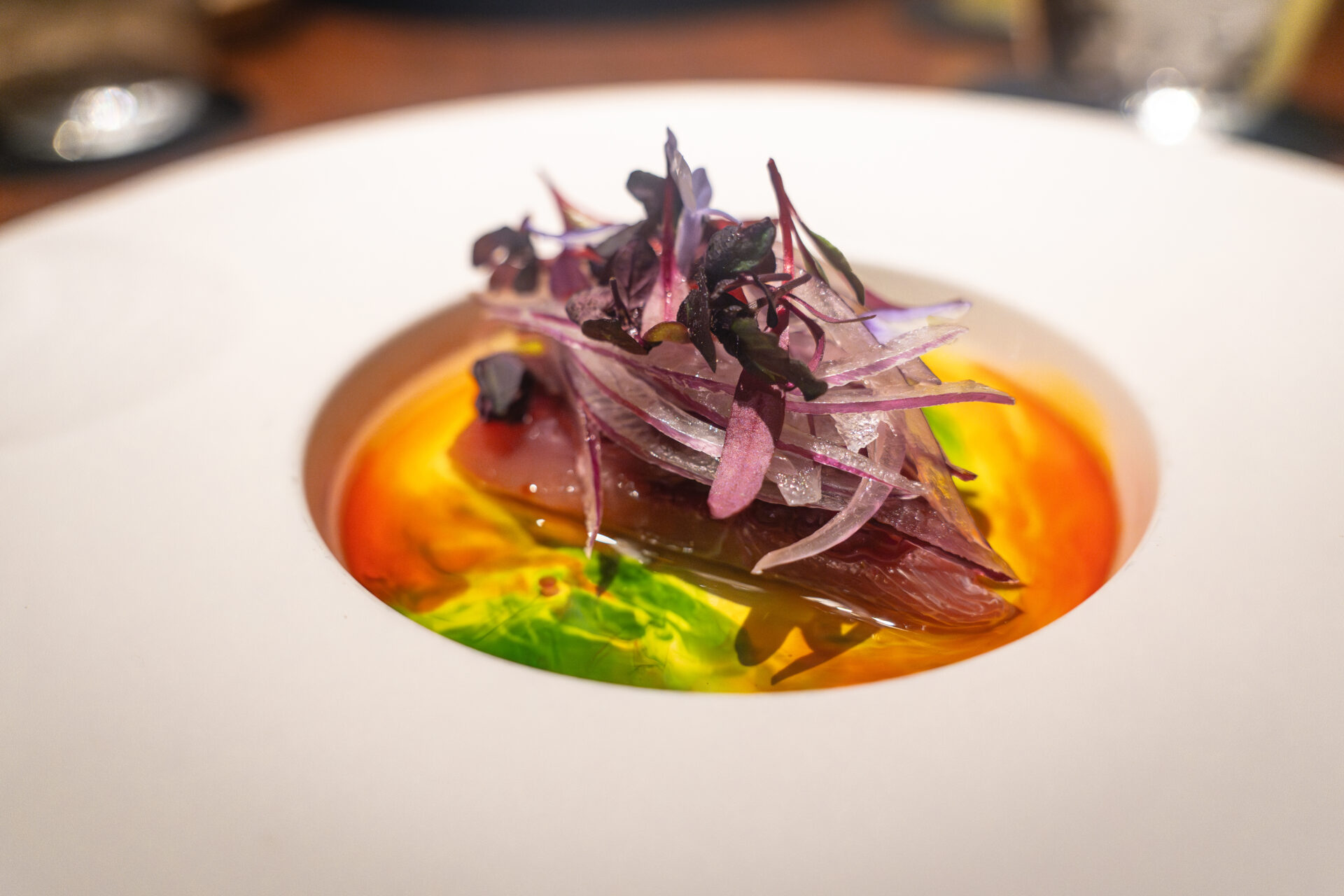
MUME Sourdough / Aged Pickled Radish Butter
Midway through the course came this earthy and resonant pairing.
House-baked sourdough arrived with a crispy crust and a moist, springy interior. Several grains were incorporated into the dough, lending layers of natural sweetness and sourness with each bite.
Served alongside was a unique fermented creation: butter blended with aged dried radish (老菜脯 / Lao Cài Pǔ). This traditional Taiwanese preserve added layers of umami and salt, transforming a simple spread into an exploration of time and tradition.
More than just bread, this pairing stood as a symbolic intersection of cultures.
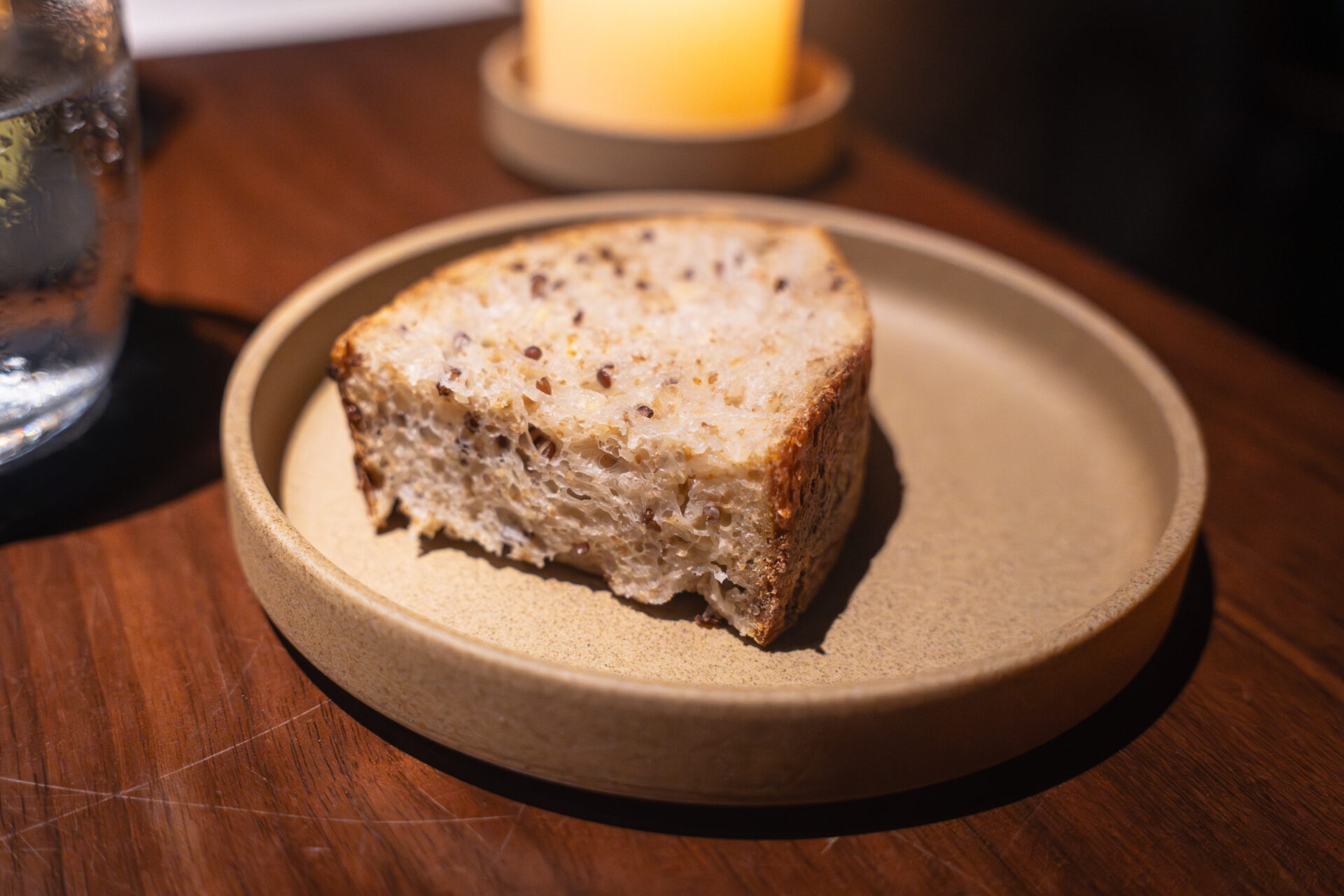


Langenlois Grüner Veltliner 2023
- Origin: Kamptal, Austria
- Grapes: Grüner Veltliner
- Tasting Notes:
A refreshing white wine with aromas of citrus and white flowers, layered with mineral notes and a hint of spice. Crisp, clean acidity adds to its lively and elegant profile.

Seasonal Fish / Crown Daisy / Chinese Kale
Prepared in the style of Japanese “crisped scale” technique, the seasonal white fish dish showcased contrast: crackling skin, moist flesh, and nuanced flavor.
A green sauce made from crown daisy (山茼蒿) and Chinese kale (芥藍) provided herbal depth and a touch of bitterness that heightened the fish’s sweetness.
Blanched stems offered a crunchy, juicy rhythm in the mouth.
This was a dish of balance and restraint, where earth, water, and produce shared the spotlight.
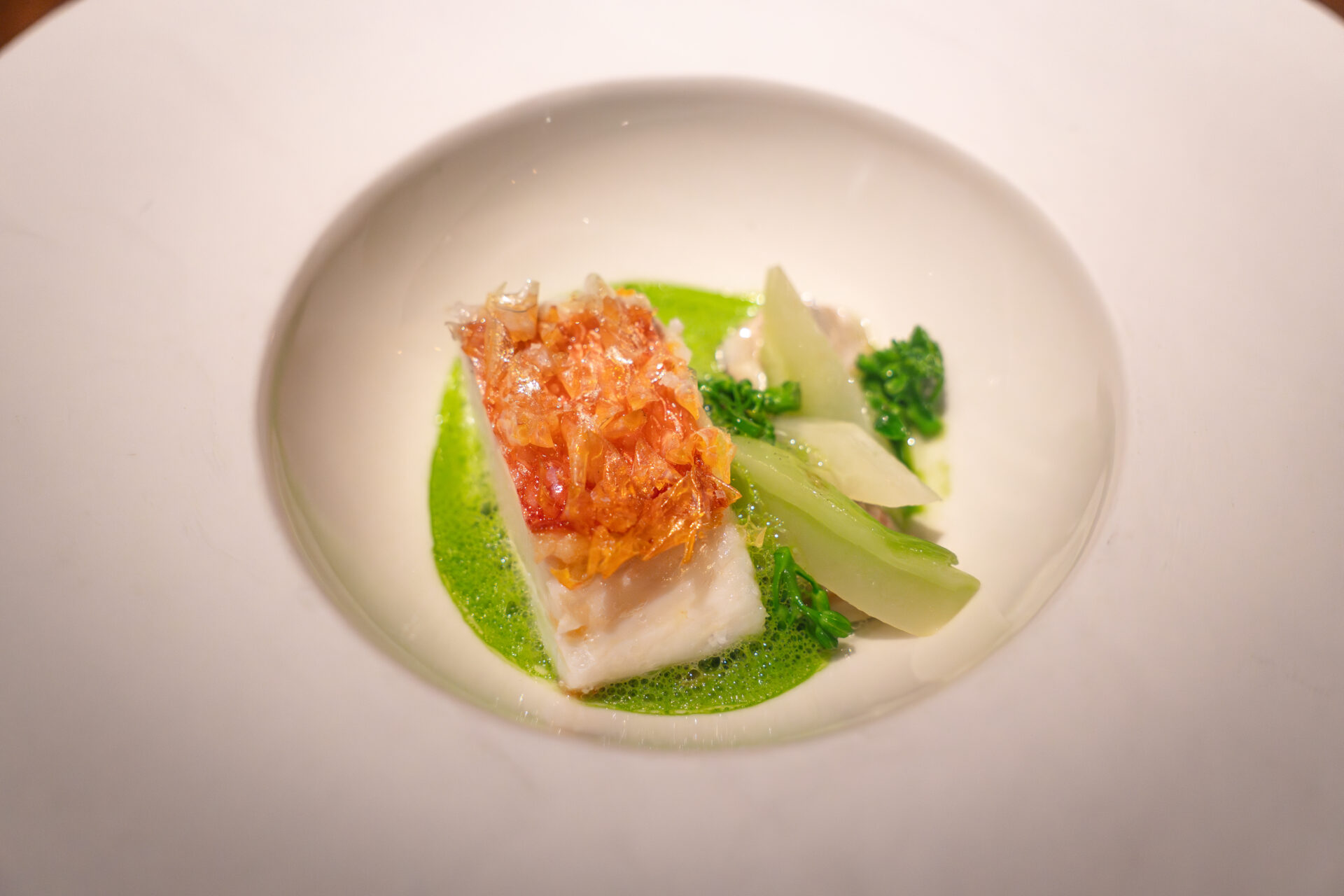
Abalone / Bitter Melon / Fermented Pineapple
A daring, complex dish built on locally beloved ingredients. Gently poached abalone was served with crisp slices of white bitter melon and deeply fermented pineapple (蔭鳳梨 / Yīn Fènglí).
The slight bitterness of the melon tightened the dish’s richness, while the fermented pineapple lent sweet acidity and aromatic depth.
Leafy greens and tendrils crowned the dish like seaweed, enhancing its maritime character. Delicate yet full of bitterness, acid, and umami that intersect dynamically—a culinary expression that felt distinctly Taiwanese, distinctly MUME.
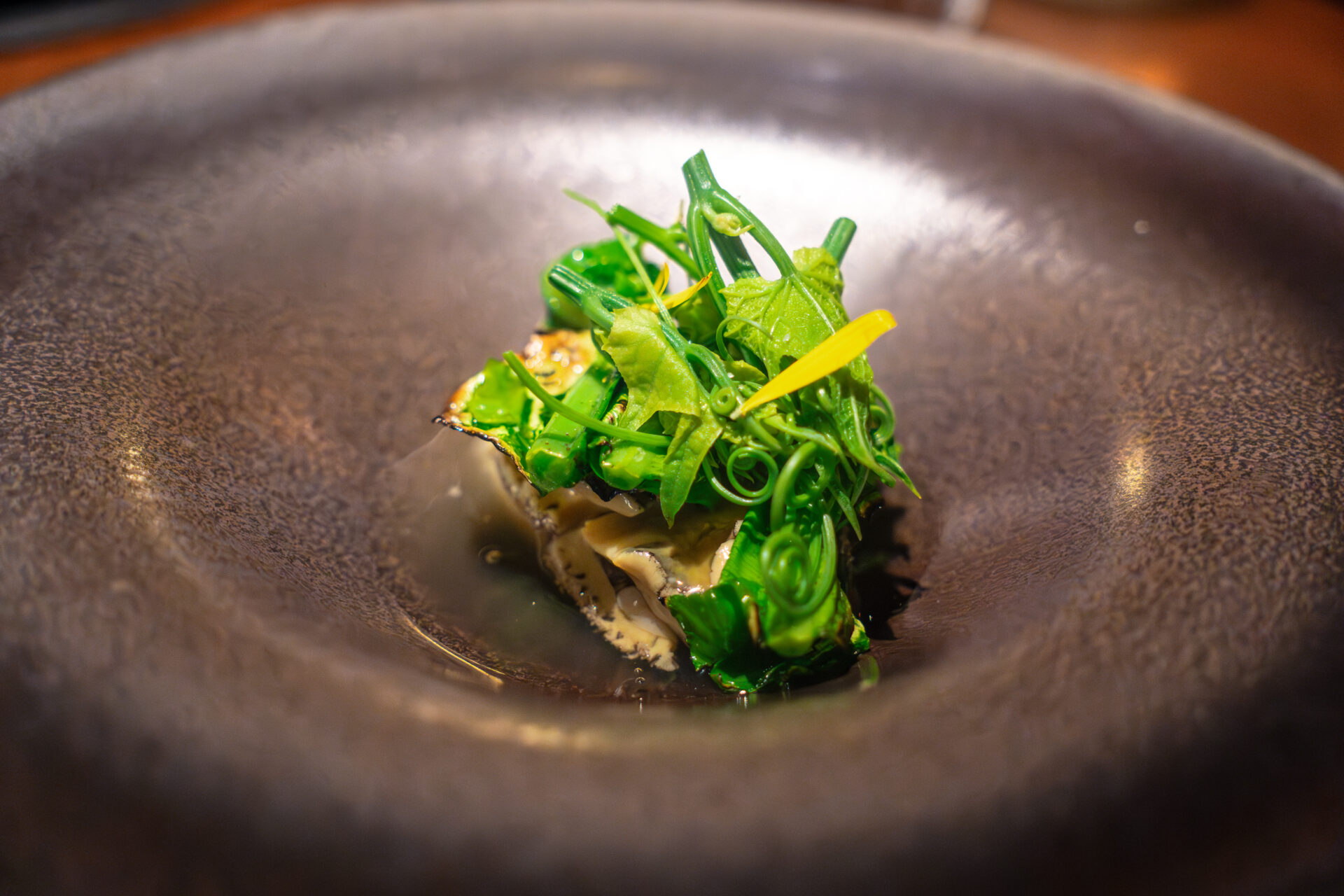
Cuttlefish / Nduja / Bell Pepper
Thin slices of cuttlefish were rolled like fettuccine, topped with MUME’s own house-made nduja-style sausage. A sweet red pepper purée formed the base, with green herb oil for contrast.
The cuttlefish’s tender yet firm texture perfectly mimicked pasta, while the fermented and spicy nduja added heat and depth. Bell pepper sweetness tied it all together, leaving a lingering, spicy note.
Though bold in concept, the dish was flawlessly executed in terms of heat, aroma, temperature, and timing. This was culinary art in motion.
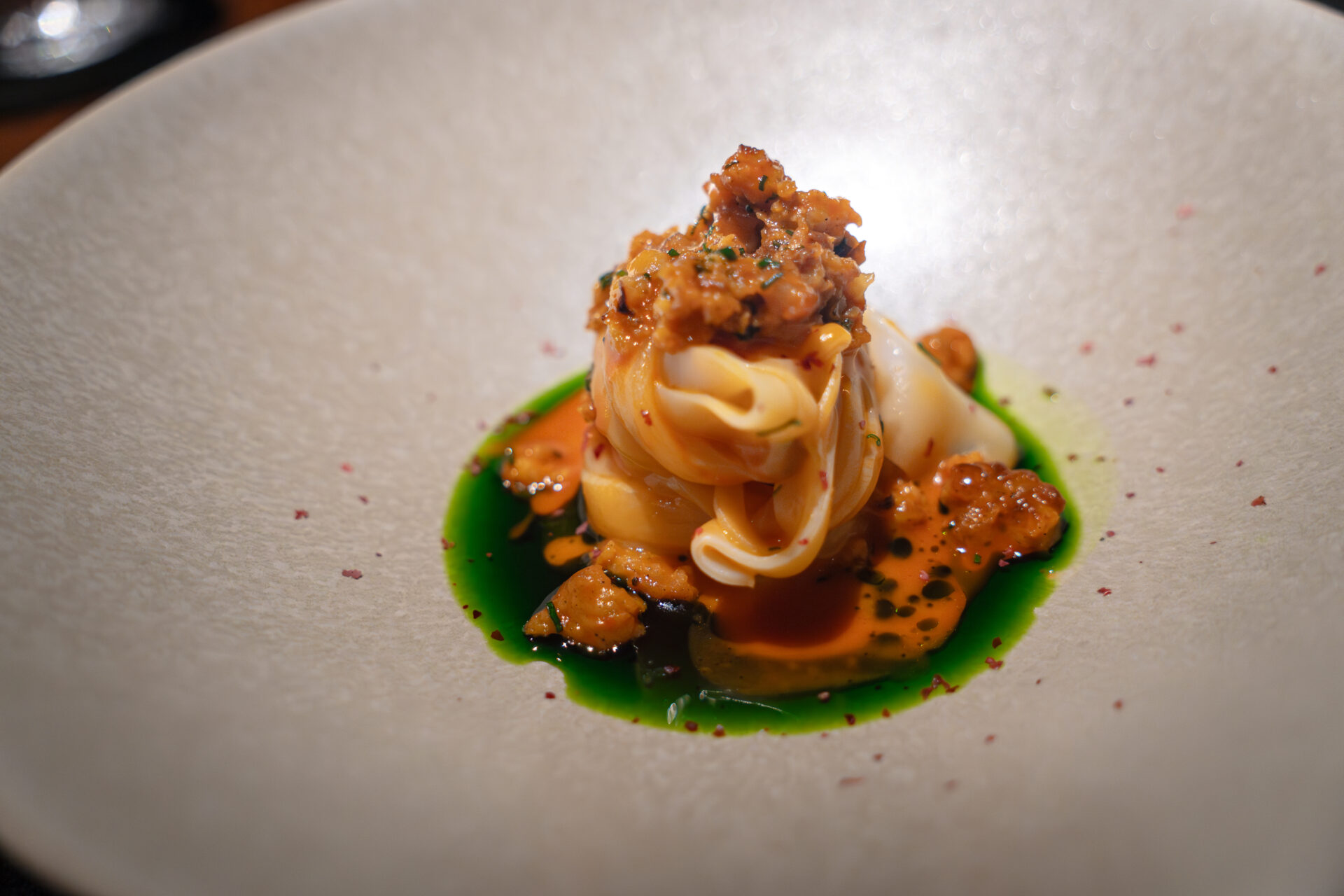
Changhua ‘Yulu’ Duck / Mulberry / Red Lettuce
Featuring the Yulu duck from Changhua, this main was both classic and wild.
Fatty duck breast was slow-cooked to tender perfection, its skin crisped just right. A sauce made from fermented mulberries brought sweetness, acidity, and earthy funk.
Grilled red romaine lettuce added contrast and freshness. Paired with a Tuscan red wine, “Morellone,” the dish opened up to reveal fruit, earth, and game in harmony.
It was a dish of depth and resonance, the kind that lingers well beyond the final bite.
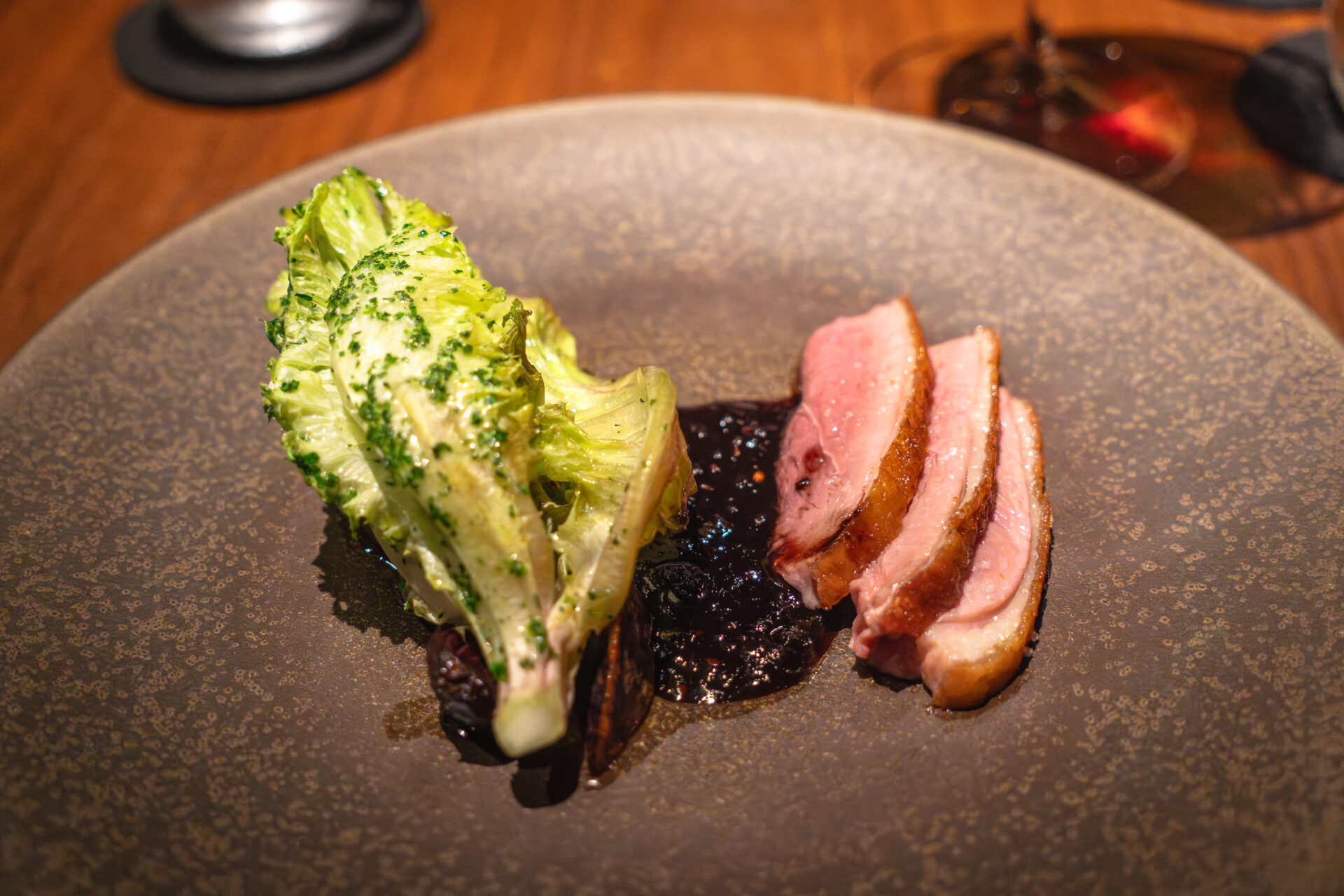
MORELLONE – Le Cinciole / Le Canelle
- Origin: Tuscany, Italy
- Grapes: Primarily Cabernet Sauvignon (Bordeaux blend)
- Tasting Notes:
This wine offers deep fruit character with mellow tannins from aging and a spicy undertone. Aromas of ripe berries, earthy soil, and dried leaves come together in a complex bouquet. It pairs beautifully with the juicy richness of duck and the sweet-acid balance of the mulberry sauce.
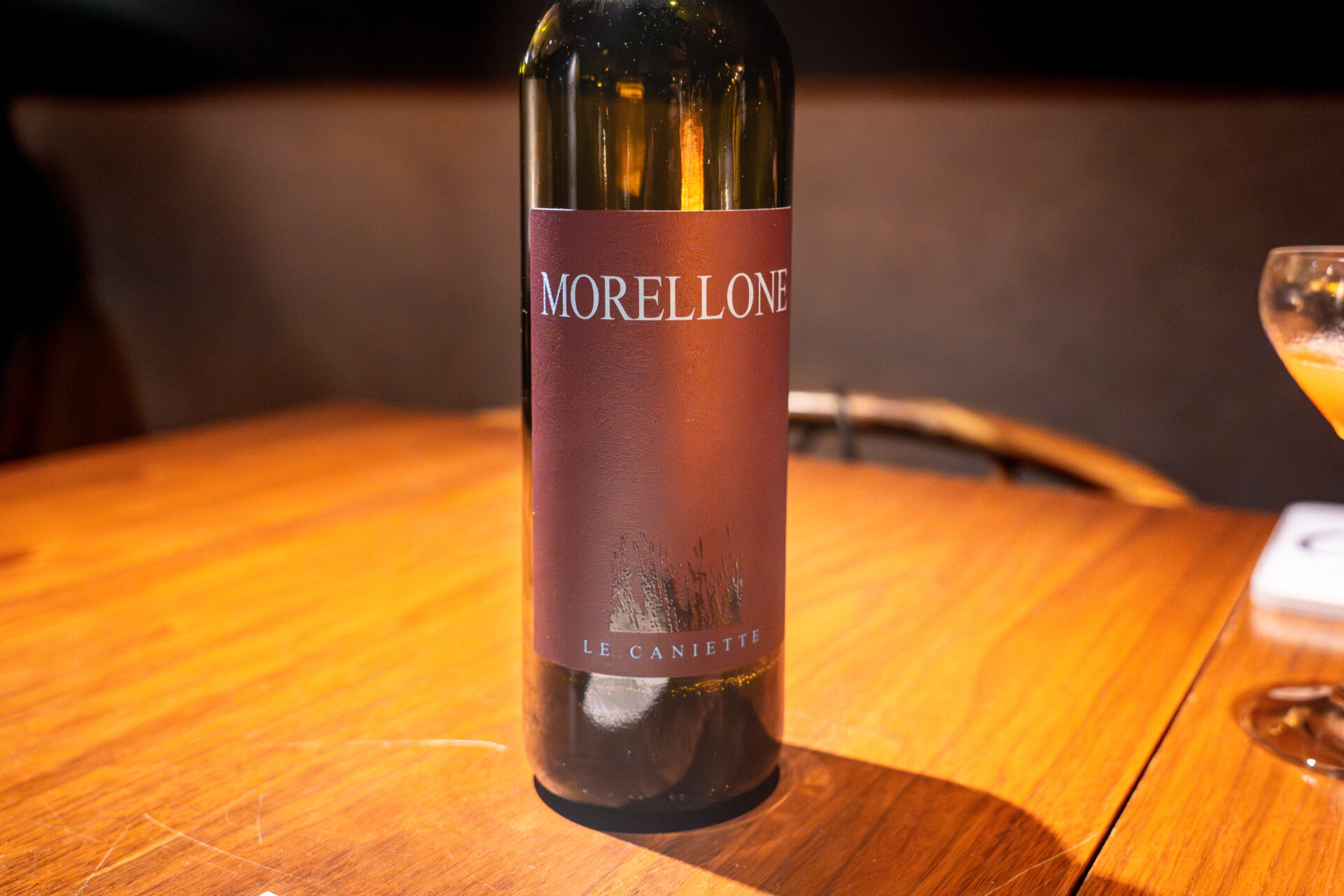
Dessert & Finale
Custard Apple / Milk / Jasmine
The dessert began with a charcoal-roasted pear, cooked whole with the skin to intensify its sweetness and add caramelized nuance.
Paired with a gently sweet vanilla flan and light yogurt cream, the flavors embraced the acidity and fragrance of the pear in a composition that was elegant, refreshing, and complete.

Choux Au Craquelin / Rose / Camellia
The final bite: a delicate choux pastry with a crisp cookie top, filled with rose-scented cream infused with camellia oil.
Subtle, floral, and rich in mouthfeel, it offered a polished and fragrant finish.
This wasn’t a dish to remember—it was a bite to remember, and a perfect ending to a meticulously curated experience.
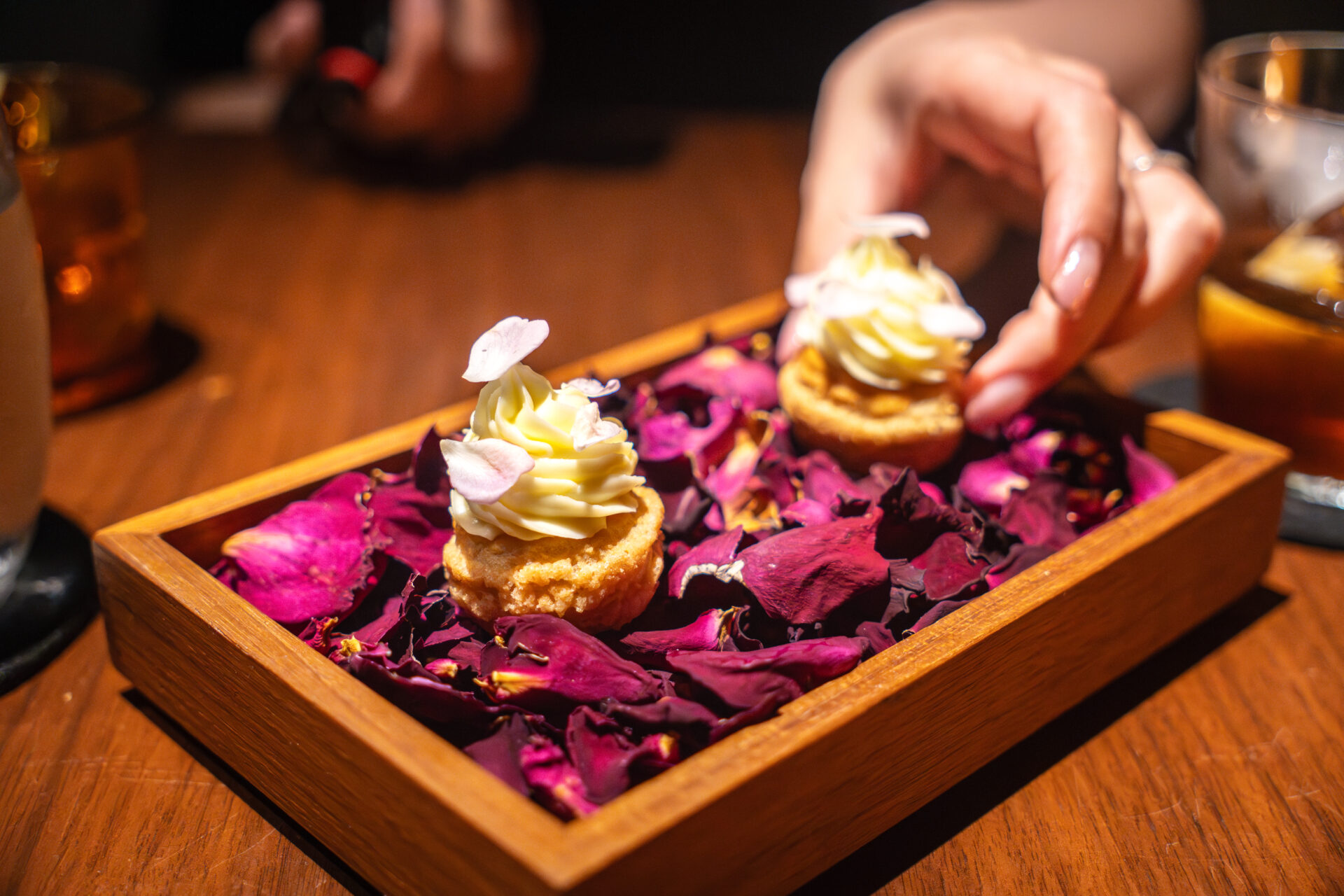
Summary & Impressions
Just a short distance away from the hustle and bustle of the city lies a space where light and shadow play in striking contrast.
Every element—from aroma to temperature to silence—is carefully considered. Each dish offered not only flavor but a sensory experience that lingered in memory.
Each plate carried the chef’s thoughtfulness and aesthetic awareness, supported by sincere and effortless service. The overall harmony of the experience, occasionally tinged with a sense of playful creativity, reminded me of the profound depth that cuisine as an expressive medium can hold.
To be honest, it’s difficult to comprehend how this restaurant could have lost its Michelin star. Given its current level of quality, every aspect—from the perfection of the dishes, to the comfort of the space, to the balance of service—was polished to a remarkable degree. MUME offered a value that clearly transcended the notion of mere “deliciousness.”
Every moment passed lightly, yet left a deep impression. This was not simply a night out during a trip; it was an experience quietly woven into the fabric of everyday memory.
It is, without a doubt, a place that makes you want to return to that table again.
Reservations & Access Information
Opening Hours: 18:00–24:00 (Last Order: 21:30)
Closed: Mondays
How to Book: Reservations can be made through MUME’s official website or via the “inline” online booking system.
Booking Slots: Two seatings per evening (18:00 or 20:30, each for a 2-hour slot)
Reservation Window: Available from one month in advance
Online Reservations: Click here to reserve
Note: As MUME is a popular destination, early booking is recommended.
Access:
Nearest MRT Stations: Xinyi Anhe Station or Da’an Station
Walking Distance: Approximately 10 minutes from either station
Located in a quiet residential neighborhood, the exterior is modest yet sophisticated.
Payment Methods:
Credit Cards: Accepted
Electronic Payments: Not available
Behind this culinary experience lies a journey.
This visit to the restaurant was a part of a larger trip titled “50 Best Gastronomic Journey.”
The full story of this journey through some of the world’s greatest food capitals is shared in the main travel logs.
→ Read the full travel chronicles here:
- TAGS


